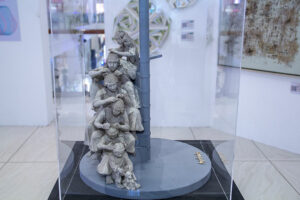MANY may wonder how a Philippine Pavilion at the Gwangju Biennale in South Korea will differ from the multiple pavilions, exhibitions, retrospectives, and whatnot that have represented the Philippines at other global art events in the past.
The answer lies in the history of Gwangju.
In 1980, it was the site of an uprising against the military government of Chun Doo-Hwan. In suppressing the protest, over 140 civilians were killed. Further back, in 1929, the city also had a major student independence movement against Imperial Japanese cruelty.
Today, Gwangju is celebrated for its strong artistic and democratic culture and history. One of the manifestations of this is the Gwangju Biennale, which started in 1995 and has been held every two years since.
“They did it to honor the city as a site of resistance. This year, their 15th edition and, incidentally, the 75th anniversary of diplomatic relations between South Korea and the Philippines, they wanted us to participate,” Avie Felix, artist and curator of the Philippine Pavilion, said at a press conference.
It marks the first time that the Korean art fair will host a pavilion from the Philippines, which has had its fair share of uprisings.
And this is why the Filipino artists of various disciplines who are part of the delegation — Toym Leon Imao, Sari Dalena, Adjani Arumpac, Paul Eric Roca, Veejay Villafranca, Dennis Montera, Karl Castro, and Ms. Felix herself — all tackle notions of resistance and freedom.
“We are all artists that are doing art because of a deep, deep love for the country, and I think that’s really what brings us together. It’s not the practice or the aesthetics. It’s the message,” she said.
UNDERSTANDING REVOLUTIONS“Locations of Freedom,” the Philippine Pavilion at the 15th Gwangju Biennale, will present a mix of sculptural installations, paintings, moving image/video art, and photographs.
It is co-funded by the Gwangju Biennale Foundation, with support from vMeme Contemporary Art Gallery, Fundacion Sanso, Imao Studios, the University of the Philippines Film Institute, and the Philippine Embassy in South Korea.
Aside from promoting Philippine contemporary art in the global space, Ms. Felix told BusinessWorld that it is a chance to present ideas that are not normally seen in other platforms.
“I’ve experienced experimenting with curation that inserts social awareness and criticality about what’s really happening in contemporary times, and getting an unexpected response. That’s why all eight of us are excited to have a space for this,” she said.
Mr. Imao, for example, is contributing his 52-piece resin and fiberglass installation Desaparecidos in honor of disappeared citizens during the Martial Law era. He is also putting up a life-size sculptural installation called Debugging, which depicts family members removing each other’s head lice, an attempt to “weed out lies perpetuated from one generation to the next.”
Filmmakers Ms. Arumpac and Ms. Dalena will provide video installations echoing Philippine history. The former bases her work Marawi Did Not Happen on experiences of people who suffered through the Mindanao city’s siege in 2017. Meanwhile, the latter dedicates her audio-visual assemblage to strong women across time, from comfort women in the Japanese occupation to the activists during Martial Law.
“I would say that what we all have in common is our aim to amplify the voices of those overlooked in our history,” Ms. Dalena told BusinessWorld.
The paintings in the Philippine Pavilion will be by Mr. Roca, whose The Paradise of Unfulfilled Promises is a triptych depicting the country’s historical events, and by Mr. Montera, whose mural, Confronting Demarcations, is an illusionary map of lines portraying the contested West Philippine Sea.
As for the photography by Mr. Villafranca, presented in the form of a giant scroll from a high vantage point, the subject is daily Filipino life. His approach is documenting seemingly mundane scenes to create “a visual journal.”
“I’d like to bear witness to the everyday revolutions in Filipinos’ lives, stemming from various challenges in post-colonial contemporary Philippines,” he said at the launch.
For Ms. Felix, whose geometric abstractions explore imagery of chaos and balance, the Philippine Pavilion is a venue for conversations about revolutions and evolutions that the group of artists have been having for years.
“We’re very eager to respond to the space and the neighboring countries who will be there,” she said, of the exhibitions by Malaysia, Cambodia, Laos, and Indonesia that will be surrounding that of the Philippines.
“This Biennale is concerned about the revolutionary spirit, and so are we.”
A preview version of “Locations of Freedom” can be seen at the second floor of Estancia Mall’s East Wing, as part of the Ortigas Art Festival until Aug. 18. The full Philippine Pavilion will be housed at Gallery 5 of the Asia Culture Center in Gwangju, South Korea from Sept. 5 to Dec. 1. — Brontë H. Lacsamana
